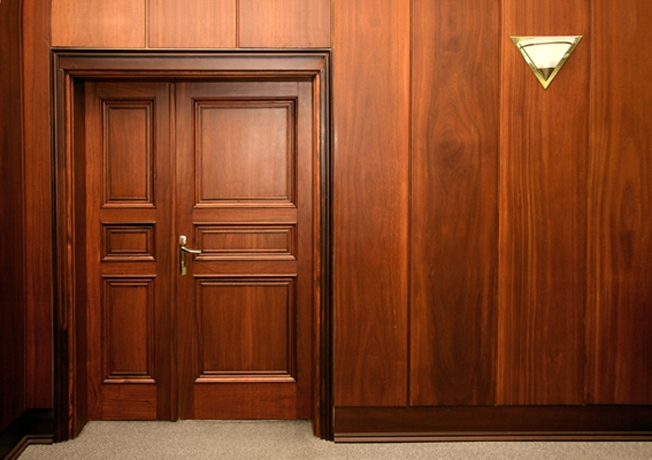
Paint wood with tinted varnish correctly!
Wood is a unique building material. It is affordable, diverse, easy to process, but at the same time quite easily vulnerable. Therefore, it needs protection that will guarantee the operation of wooden products and structures for a long time. One of the types of wood protection is its treatment with colorless or tinted varnishes.
As a rule, valuable (expensive, "noble") wood species (oak, beech, mahogany, etc.) are not treated with tinted varnishes. Colorless transparent agents (varnishes, decorative and protective agents, oils) are used for their treatment.
Tinted varnishes are most often used for the treatment of less valuable (inexpensive) wood species (for example, common pine). When treating wood with tinted varnish, two tasks are solved. The first is to protect the surface from damage (atmospheric, mechanical, etc.), and the second is to give the wood "nobility", that is, to visually "transform" a less valuable wood species into a road (for example, to "transform" a common pine into a mahogany).

Features of applying tinted varnishes
Gloss. Most wood species have a fairly porous structure that absorbs varnish well. That is why when applying the first layer of varnish (on unprimed wood), a matte surface is usually obtained, even when using glossy varnish. The second layer is not so strongly absorbed into the surface and, as a rule, provides the necessary gloss. However, for very porous wood species, three (and sometimes more) layers of varnish are required to obtain the necessary gloss. If, when applying tinted varnish, the desired color of the wood is already obtained, but the gloss (due to strong wood absorption) is not yet achieved, then 1–2 layers of untinted varnish must be applied on top of the tinted varnish until the required degree of gloss is achieved.
Contrasting pattern (texture) of wood. To obtain the maximum effect that emphasizes the contrasting pattern (texture) of wood (grains, annual rings, knots), it is recommended to apply tinted varnish to a surface that has been sanded to a clean wood and has not been primed. In this case, the varnish will be maximally absorbed into the wood. At the same time, different parts of the surface have different absorbency, which is why more varnish and with it color pigment will be absorbed into more porous parts of the surface, and less into harder parts. If the surface of the wood is primed with a primer (special protective or pore filler), then the absorbency of different areas of the wood decreases, and because of this, the contrast of the wood pattern (with subsequent application of tinted varnish) decreases. In the case of priming the surface not with a primer, but with a colorless varnish, its absorbency decreases very much (practically "to zero" and becomes the same on the entire surface). Therefore, when applying colored varnish to such a surface, there will be no contrasting pattern (texture) of the wood.
Color, color saturation and covering power. If tinted varnish is applied to the surface in several layers, the influence of the original color of the wood is slightly reduced, but the more layers are applied, the greater the covering power of the coating and the weaker the pattern (texture) on the wood will be visible. The thicker the layer (film) of the dried tinted varnish, the darker it is (the more saturated the color), because it contains more pigment. If you tint the varnish in dark colors, then when applying a thick layer, the tinted varnish will cover the surface very strongly, almost like paint. When applying tinted varnishes to wood, it is necessary to take into account that the color of the wood, its texture and pattern will be visible through the translucent tinted varnish. Because of this, sometimes there may be a problem of discrepancy between the shades of the actual coating obtained and the standard in the catalog. If it is necessary to obtain a tone that is lighter than in the catalog, the tinted varnish must be diluted with colorless varnish or a suitable solvent. For acrylic water-based varnish, such a solvent is water. If it is necessary to obtain a more saturated color of the surface, the tinted varnish is applied in several layers, but it should be borne in mind that the covering ability of the varnish will increase. The final color of the coating is also affected by the type of varnish, namely its binder. Thus, alkyd varnishes add to the main color tone also the yellowish-brown color of the resin, which is part of their binder. Acrylic varnishes form a completely transparent colorless film and do not affect the main color tone.

General recommendations.
- - Colored varnish should be applied in thin, even layers to obtain a uniform color on the entire surface. The varnish is applied with a brush along the wood fibers from the beginning to the end of the board. When applying, the varnish is rubbed well into the wood surface.
- - When using water-soluble varnishes, it is necessary to take into account that they give the surface roughness, raising the wood fibers. After the varnish dries, the surface must be carefully sanded. For sanding, use fine-grained sandpaper with a grain of "240" or even finer. The applied colored varnish must be sanded very carefully so as not to remove the colored varnish film along with the pile.
- - The structure of the surface also significantly affects the saturation of the color of the coating. Rough and porous bases absorb the varnish more strongly and therefore look darker (saturated) than smooth and well-polished ones.
- - The perception of the color of the coating is also influenced by the degree of gloss of the coating. Glossy surfaces look darker.
- - The binders of different types of varnishes differ in color, which also affects the final color of the coating.
- - Acrylic varnishes form a completely transparent colorless film.
- - Alkyd varnishes form a yellowish-brown film.
- - All transparent alkyd varnish products, when applied to wood, necessarily give it a color from light yellow to dark brown, that is, they “light up” the wood. The color depends on the type of resin that was used as a binder. Thus, the dried alkyd film gives the wood yellow tones. When tinting alkyd varnishes, it must be remembered that the “yellowness” of the varnish itself will be added to the main color.







